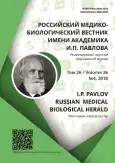Experimental study of effectiveness of ear protection devices for prevention of intense noise exposure
- 作者: Kharitonov V.I.1
-
隶属关系:
- Ryazan State Medical University
- 期: 卷 26, 编号 4 (2018)
- 页面: 484-492
- 栏目: Original study
- URL: https://journals.rcsi.science/pavlovj/article/view/10843
- DOI: https://doi.org/10.23888/PAVLOVJ2018264484-492
- ID: 10843
如何引用文章
详细
Occupational neurosensory deafness is one of central problems in the occupational medicine. Hearing loss associated with professional activity is the leading occupational disease with the permanently increasing share. In the industries with a very high level of noise it is recommended to use a combination of earplugs and earmuffs, and to control the condition of the ear analyzer, which provided a 3-fold increase in regular use of anti-noise earplugs.
Aim. To evaluates effectiveness of sound damping capacity of ear protectors and of their combinations on exposure to intermittent and impulse noise.
Materials and Methods. Several types of ear protectors of domestic and foreign manufacture were studied: earplugs of Berushi (Russia) and EAR (Great Britain) types, ShZO-1 earmuffs (Russia) and also earmuffs in conjunction with KKA helmet (Russia). The study was conducted in compliance with the rules and regulations of the effective standards and methodical instructions in the conditions of laboratory experiments and of real production. In the experiment, noise exposure was modeled in anechoic acoustic chamber, after which audiometric research was conducted on test subjects. In real industrial conditions, dimension of levels and noise exposure at the workplaces and the condition of the auditory analyzer of workers were controlled. For subjective evaluation of the design and comfort of the used ear protecting devices and their combinations, questionnaire-based survey was conducted.
Results. The results of the laboratory experiment and research work in the conditions of the real production permit to suggest high effectiveness of the evaluated ear protectors and of their combinations, and, taking into the account the criterion of preservation of hearing, the quality of hearing protection can be characterized as «good». Questionnaire survey of test persons showed a high sound damping capacity and convenience of the tested ear protectors and permitted to compile the data bank of comments and proposals concerning convenience of their use and their design.
Conclusions. Laboratory and industrial studies showed a high effectiveness of the tested ear protectors and the possibility of their practical use in the conditions of real production with exposure to extreme levels of intense impulse noise, with the obligatory permanent monitoring of correctness and timeliness of their application.
作者简介
Valeriy Kharitonov
Ryazan State Medical University
编辑信件的主要联系方式.
Email: prof-haritonov@yandex.ru
ORCID iD: 0000-0002-7098-6130
SPIN 代码: 1340-1347
Researcher ID: U-2153-2017
MD, PhD, Professor of the Department of Specialized Hygienic Disciplines with the Course of Hygiene, Epidemiology and Organization of the State Sanitary Service, the Faculty of Additional Postgraduate Education
俄罗斯联邦, 9,Vysokovoltnaja,Ryazan,390026参考
- Izmerov NF, Denisov ÉI, Adeninskaia EE, et al. Criteria for the assessment of the noise-induced occupational hearing loss: international and national standards. Bulletin of Otorhinolaryngology. 2014;3: 66-71. (In Russ).
- Kharitonov VI. Modern state of the problem impacts multiple intensive labour in medicine. I.P. Pavlov Russian Medical Biological Herald. 2012; 4:185-8. (In Russ).
- Kharitonov VI. Gigiyenicheskaya otsenka fizicheskikh kharakteristik impul’snykh shuchmov shtampovoch-nogo i kuznechnopressovogo proizvodstva, poteri slukha i profilaktika. Gigiyena truda i professional’nyye zabolevaniya. 1989;7:8-11. (In Russ).
- Izmerov NF, Kharitonov VI. Risk Assessment and Risk Management in Dangerous Occupations (on an Example of Hot Wording Forgers). Central European Journal of Occupational and Environmental Medicine. 1995;1(4):311-8.
- Suvorov G, Denisov E, Starck J, et al. Effects of Peak Levels and Number of Impulses to Hearing Among Forge Hammering Workers. Applied Occupational and Enviromental Hygiene. 2001;16(8): 816-22. doi: 10.1080/10473220119058
- Denisov EI, Adeninskaya EE, Eryomin AL, et al. Occupational deafness – problem of health and safety. Occupational Health and Industrial Ecology. 2014;7:45-7. (In Russ).
- Starck J, Toppila E, Laitinen H, et al. The attenuation of hearing protectors against high-level industrial impulse noise; comparison of predicted and in situ results. Applied Acoustics. 2002;63(1):1-8. doi:10. 1016/s0003-682x(01)00025-1
- GOST 12.4.051-87 (ST S•EV 5803-86) Sistema standartov bezopasnosti truda (SSBT). Sredstva individual’noy zashchity organa slukha. Obshchiye tekhnicheskiye trebovaniya i metody ispytaniy. Moscow; 1987. (In Russ).
- GOST R 12.4.208-99 SSBT. SIZ organa slukha. Naushniki. Obshchiye tekhnicheskiye trebovaniya. Moscow; 1999. (In Russ).
- GOST R 12.4.209-99 SSBT. SIZ organa slukha. Vkladyshi. Obshchiye tekhnicheskiye trebovaniya. Moscow;1999. (In Russ).
- GOST R 12.4.210-99 SSBT. SIZ organa slukha. Protivosh•chmnyye naushniki, smontirovannyye s zashchitnoy kaskoy. Obshchiye tekhnicheskiye trebovaniya. Moscow; 1999. (In Russ).
- GOST R 12.4.211-99 SSBT. SIZ organa slukha. Protivosh•chmy. Sub’yektivnyy metod izmereniya pogloshcheniya zvuka. Moscow; 1999. (In Russ).
- GOST R 12.4.212-99 SSBT. SIZ organa slukha. Protivosh•chmy. Otsenka rezul’tiruyushchego zna-cheniya A-korrektirovannogo urovnya zvukovogo davleniya pri ispol’zovanii sredstv individual’noy zashchity. Moscow; 1999. (In Russ).
- GOST R 12.4.213-99 SSBT. SIZ organa slukha. Protivosh•chmy. Uproshchennyy metod izmereniya akusticheskoy effektivnosti protivosh•chmnykh naushnikov dlya otsenki kachestva. Moscow; 1999. (In Russ).
- Profilaktika professional’noy tugoukhosti u lits «shuchmovykh» professiy. Moscow: Health Ministry; 1988. №10-11/46. (In Russ).
- Diagnostika, ekspertiza trudosposobnosti i profilaktika professional’noy sensonevral’noy tugoukhosti. Pis’mo Minzdrava RF ot 6 noyabrya 2012 g. №14-1/10/2-3508. Moscow; 2012. (In Russ).
- GOST 12.4.062-78 SSBT. Shum. Metody opredeleniya poter’ slukha cheloveka. Moscow; 1978. (In Russ).
补充文件







